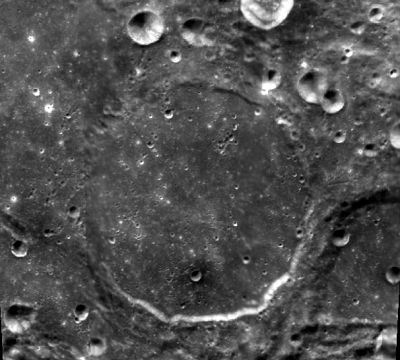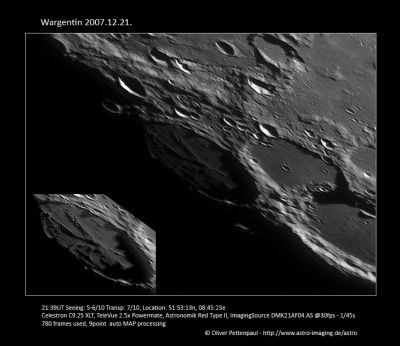Wargentin
Contents
Wargentin
|
Lat: 49.6°S, Long: 60.2°W, Diam: 84 km, Depth: 0.3 km, Rükl: 70 |


Left: Clementine Wargentin is in the center, with areas where the crater flooding has overtopped the rim evident on the west and northwest. The crater Nasmyth is partially visible in the lower right. Right: Oliver Pettenpaul In this Earth-based view, Wargentin is seen at a very low sun angle, along the terminator. The "bird's foot" pattern on the surface (referred to by Elger) is evident, and the shadows cast by the remnants of the rim in the southeast indicate they stand about 1 km above the floor. To their right is the crater Nasmyth and diagonally below that, Phocylides. A small part of the large crater Schickard can be seen along the top margin.
Images
LPOD Photo Gallery Lunar Orbiter Images
- Photo of Nasmyth's (?) antique plaster model of Wargentin and surroundings attributed to Samuel Castner, Jr..
Maps
(LAC zone 124B1) USGS Digital Atlas PDF
Description
Description: Elger
(IAU Directions) WARGENTIN.--A most remarkable member of the Phocylides group, flanking the S.W. side of Schickard. Unlike the majority of lunar formations, its floor is raised considerably above the surrounding region, so that it resembles a shallow oval dish turned upside down. It is 54 miles in diameter, and, except on the S.E. (where it abuts on Phocylides b, and for some distance is bounded by its wall), it has only a border of very moderate dimensions. On the N.W. slope of this ghostly rampart I have seen a distinct little crater, and two much larger depressions on the N.E. slope. There are some low ridges on the floor, radiating from a nearly central point, which have been aptly compared to a bird's foot.
Description: Wikipedia
Additional Information
Depth data from Kurt Fisher database
- Pike, 1976: 0.3 km
- Westfall, 2000: 0.3 km
- Viscardy, 1985: 0.3 km
Nomenclature
- Named for Pehr Wilhelm Wargentin (September 22, 1717 – December 12, 1783), a Swedish astronomer. When Pehr Wargentin was 12 years old he observed a (total) lunar eclipse which would spark his life-long interest in Astronomy. Wargentin made studies on the moons of Jupiter and published his first paper on the topic in 1741 in the Acta of the Royal Society of Sciences in Uppsala.
- According to Whitaker (p. 218), this name was introduced by Schröter.
- The wrinkle ridges on the floor of Wargentin are unofficially called Dorsa Wargentin by - DannyCaes Aug 21, 2011
- Erroneously printed as Wargenten on page 76 (libration chart 5) in the 21st Century Atlas of the Moon (2012).- DannyCaes Jan 23, 2013
LPOD Articles
Southwest Taper. Sunrise on an Unflat Plain
Lunar 100
L43: A crater filled to the rim with lava or ejecta.
Bibliography
- Blewett, D. T., B. R. Hawke, P. G. Lucey, G. J. Taylor, R. Jaumann & P. D. Spudis (1995) Remote sensing and geologic studies of the Schiller-Schickard region of the Moon. J. Geohys. Res. 100, E8, 16,959-16,977.
- Hawke, B. R. /et al./ 2007. Remote Sensing Studies of the Schiller-Schickard Region of the Moon: Final Results. 38th Lunar and Planetary Science Conference, (Lunar and Planetary Science XXXVIII), held March 12-16, 2007 in League City, Texas. LPI Contribution No. 1338, p.1474
- Wood, C.A. 2/2007. Hidden Maria and Dusty Debris. S&T 113(2):62
- Harold Hill. A Portfolio of Lunar Drawings, pages 162, 163.
- Google Scholar listings